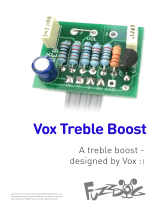Page is loading ...

SUNNY-T
Into the realms of a cranked
Sunn Model T amp
Contents of this document are ©2016 Pedal Parts Ltd.
No reproduction permitted without the express written
permission of Pedal Parts Ltd. All rights reserved.

Schematic + BOM
R1 1M
R2 68K
R3 CLR (2K2)
C1 10u elec
C2 10u elec
C3 1u elec
C4 1u elec
C5 100u elec
C6 4n7
IC1-2 LM386N1*
D1 1N4001
VOL 100KA
GAIN 1MC**
*You can use LM386 with higher ratings (N3, N4) if
you prefer. This will give you less distortion, and a
much more open sound. That’s not what this circuit
is about though, so we recommend sticking with N1.
**The original circuit only has a Volume control, so
our Gain control is entirely optional. It basically
replicates the volume control of your guitar, limiting
the input signal. If you aren’t using a gain control you
must jumper pads 2 and 3 of GAIN - see next page.

The power and signal pads on the PCB conform to the FuzzDog Direct Connection
format, so can be paired with the appropriate daughterboard for quick and easy
offboard wiring.
Its best to use sockets for the ICs as they’re very sensitive to heat.
The cathode (striped end) of the diode goes into the square pad. The anode (long
leg) of electrolytic capacitors go into the square pads.
Pots mount on the opposite side to the rest of the components - see cover image.
If you aren’t using a pot for GAIN, place a jumper wire across pads 2 and 3 as
shown in red above.
There are two sets of pads for your VOLUME control, depending on whether you’re
building this as a one or two knob pedal. Use only VOL1 or VOL2, not both.
PCB Layout ©2016 Pedal Parts Ltd.
1

Test the board!
UNDER NO CIRCUMSTANCES will troubleshooting help
be offered if you have skipped this stage. No exceptions.
Once you’ve finished the circuit it makes sense to test is before
starting on the switch and LED wiring. It’ll cut down
troubleshooting time in the long run. If the circuit works at this
stage, but it doesn’t once you wire up the switch - guess what?
You’ve probably made a mistake with the switch.
Solder some nice, long lengths of wire to the board connections for
9V, GND, IN and OUT. Connect IN and OUT to the jacks as shown.
Connect all the GNDs together (twist them up and add a small
amount of solder to tack it). Connect the battery + lead to the 9V
wire, same method. Plug in. Go!
If it works, crack on and do your switch wiring. If not... aw man.
At least you know the problem is with the circuit. Find out why, get
it working, THEN worry about the switch etc.
BATTERY
IN OUT
Your nice, new circuit board
INCLUDING WIRED POTS!!!!
IN 9V GND OUT

(if using a daughterboard please refer to the relevant document)
Wire it up - with battery
This circuit is standard, Negative GND. Your power supply should be
Tip Negative / Sleeve Positive. That’s the same as your standard pedals
(Boss etc), and you can safely daisy-chain your supply to this pedal.
The BOARD GND connections don’t all have to connect to one point. They
can be daisy-chained around the circuit, using larger connection points
(such as jack socket lugs) for multiple connections. As long as they all
connect together in some way.
PedalParts.co.uk
L
E
D
BOARD
OUT
BOARD
9V
BOARD
GND
BOARD
GND
BOARD
GND
BOARD
INPUT
BATTERY
+
IN
OUT
L
E
D
BOARD
GND
BOARD
LED+
+

This template is a rough guide only. You should ensure correct marking of your
enclosure before drilling. You use this template at your own risk.
Pedal Parts Ltd can accept no responsibility for incorrect drilling of enclosures.
PedalParts.co.uk
Drilling template
Hammond 1590B
60 x 111 x 31mm
Recommended drill sizes:
Pots 7mm
Jacks 10mm
Footswitch 12mm
DC Socket 12mm
32mm
/









